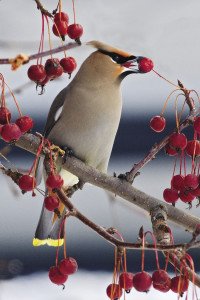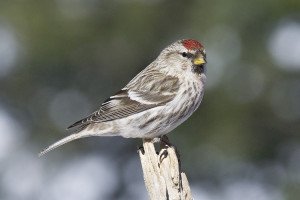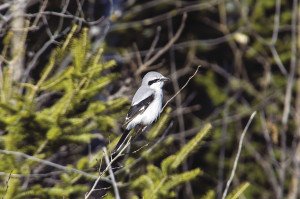Story by David Dudley
Photos by Earl Orf

When most people think about viewing birds, usually the middle of winter doesn’t come to mind. But winter is one of the best seasons to see birds, as some venture south out of the high arctic tundra and northern boreal forest in search of food. This particular winter is poised to be especially exciting along the North Shore.
Mike Hendrickson, a northeastern Minnesota birding guide for the past 30 years, says “Right now, common redpolls are moving down the North Shore in good numbers. And yes, this winter will be a very good year for common redpolls. Other finches, like pine siskins and American goldfinches, will be in good numbers in the Northland. The best way to attract these finches is having your feeders stocked with black oil sunflower seeds and keep thistle feeders filled.”
He adds, “Once there is snow on the ground, the birds will visit the feeders and most times, the finches will continue to hit the same feeders until it’s time to move north in late March and early April.”
As bird populations grow and food becomes limited, birds travel far outside of their normal range in large numbers, leading to what ornithologists and bird-watching enthusiasts refer to as an irruption. Sometimes, several species experience an irruption simultaneously, resulting in a spectacular “super flight” of birds. This occurred across the U.S. and Canada in the record-breaking winters of 1997-1998 and 2012-2013.

Although a once-in-a-decade super flight is not likely this winter, a regional increase among some birds along the North Shore is likely. Every year, Ron Pittaway, of the Ontario Field Ornithologists, publishes a report forecasting winter finch movements across North America. Several sources on annual tree seed crops are compiled to determine which areas can expect to see higher than usual bird movements. U.S. and Canadian forests that have bumper crops of cones, catkins, seeds, and berries are where the hungry birds can be expected to go during any given winter.
This winter, cone crops are generally poor from central Ontario eastward to the Atlantic provinces and northeastern states. Mountain ash berries are very good across most of the boreal forest and birch seed crops are poor to average. The different northern songbird species, known as winter finches, travel in nomadic flocks seeking out suitable seeds throughout the winter.

Each of the winter finch species is a specialist when it comes to eating the seeds of a certain tree. Pine grosbeaks eat the seeds contained within the mountain ash berries and discard the rest. A telltale sign of pine grosbeaks at work is when the snow beneath a mountain ash tree is littered with blooms of pinkish stains from the berries’ flesh. Common redpolls are birch seed specialists and flocks along the North Shore may have the occasional hoary redpoll, a more northern-dwelling cousin, tagging along.
Perhaps the best example of a seed specialist is the crossbill. Crossbills have scissor-shaped mandibles designed to pry apart the scales of pine cones in order to extract the seed. There are even “left-handed” and “right-handed” crossbills with different beak sizes to accommodate different types of cones.

Crossbills can be difficult to find as they roam far and wide in search of cones. According to Hendrickson, “As far as white-winged crossbills and red crossbills, there isn’t much anyone can do to bring them to their feeders, but occasionally red crossbills will visit. To view these birds, drive along roads that have a lot of pine trees and listen for the chip-chip calls of the red crossbills. People may see these finches eating grit on the road.”
There are 10 “types” of red crossbills that are best differentiated by their flight calls. Perhaps because of their wide-ranging habits in remote locations, these birds are poorly understood. People who come across a flock and manage to record their calls, with something as simple as a cell phone, can submit the recording to Matt Young, a researcher at the Cornell Lab of Ornithology. He will not only determine which type of red crossbill it is, but the information will be incorporated into a larger study, helping to understand this elusive bird and the broader health of the ecosystem, including the trees.

Currently, type 3 red crossbills have been congregating in the Great Lakes region and they will continue to move as cone crops become exhausted. White-winged crossbills are experiencing good cone crops across their more northerly range and are less likely to venture south this year, although a flock was spotted near Thunder Bay in late November.
Evening grosbeaks and purple finches used to be seen quite often, but have declined over the past several decades along the North Shore. Many believe this is due to a restored natural balance between forest fires and reduced spruce budworm outbreaks. Both evening grosbeaks and purple finches, however, won’t hesitate to visit a backyard bird feeder if they happen to come upon one.
In fact, all of the winter finches are likely to appear at an adequately stocked bird feeder, with perhaps the exception of the two crossbill species and bohemian waxwings (which are sometimes included as winter finches and are more likely to eat ornamental crab apples from the backyard than seeds from a feeder).
American goldfinches are perennial staples at local bird feeders and pine siskins, which were noticeably absent a few winters ago, should show up in numbers again this year. Keeping bird feeders can be one of the surest ways to revel at the buzzing, chatty flocks that spend most of the year hiding in thick conifer stands.
Some people choose to provide a bird bath so the birds can have access to an unfrozen water source. Winter finches eating seeds do not require drinking water as their bodies produce enough as a metabolic byproduct from digesting the grains. Some birds that may be supplementing the seeds in their diet with dormant insects will appreciate the drinking water. Some people swear the only way to attract evening grosbeaks is to provide a heated bird bath.
Finches aren’t the only winter visitors attracted to bird feeders. Northern shrikes also make their way south as food supplies dwindle. However, their preferred food is other birds and small mammals. People who have feeders might see a sleek, grayish bird with a black mask and hooked beak perched nearby, especially if there is a large open yard, meadow or bog in the area. Shrikes are notorious for killing more than they can immediately eat, sometimes impaling their prey on barbed wire or thorns to serve as a storage larder for later consumption. Chances are, if there is a northern shrike hanging around the bird feeder, the winter finches won’t be staying very long.
Even without feeders, there are still opportunities to observe some beautiful arctic birds that find themselves in open water harbors along the shores of Lake Superior. Deep-diving sea ducks, such as scoters, long-tailed ducks and harlequin ducks will be seen from time to time. Last year, an eider spent the entire winter at Canal Park in Duluth. Sometimes even a parking lot or rooftop full of gulls can present a surprise, such as the enormous glaucous gull or an Iceland gull, both of which only ever come about as far south as the mid-latitudes.
Other birds that are year-round residents seem to become more visible in the winter months. Bald eagles tend to stay near busy roadways as the lakes begin to freeze. Owls also begin to become more vocal as they prepare for their late winter breeding season and ravens, crows and jays seem to grow bolder in the winter as well.
Winter birds roam widely and it’s sometimes difficult to locate the rare visitors. Luckily, birders in Minnesota have some great resources at their fingertips. Richard Hoeg, a volunteer naturalist at the Sax-Zim Bog, recently developed a free app for tablets and phones that helps connect the community of Minnesota birders.
In his words, “The app provides automatic updates from Minnesota bird blogs, web sites, bird sightings and photos. Thus, the user can read about birding news in Minnesota while learning about rare bird sightings.”
Because of the popularity of birding in the area, locations of rare birds are posted and updated almost daily. Just remember that these birds are sometimes spotted on private property, so check before visiting a location and always remember to keep a reasonable distance away from the birds, they are wild animals after all.
